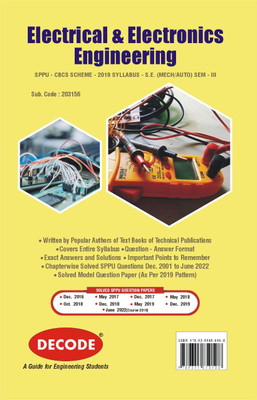Electrical and Electronics Engineering for SPPU 19 Course (SE - III - Mech./Auto. - 203156) (Decode)(Paperback, UDAY A. BAKSHI, ATUL P. GODSE, ANUP GOEL)
Quick Overview
Product Price Comparison
Unit IIntroduction to ArduinoIntroduction to microcontroller and microprocessors, role of embedded systems, open source embedded platforms, Introduction to Arduino IDE- features, IDE overview, Programming concepts : variables, functions, conditional statements, Concept of GPIO in Atmega328 based Arduino board, digital input and output. (Chapter- 1)Unit IIPeripheral InterfaceInterfacing of Atmega328 based Arduino board with LED and LCD/serial monitor, serial communication using Arduino IDE, Concept of ADC in Atmega328 based Arduino board, interfacing of Atmega328 based Arduino board with temperature sensor (LM35), LVDT, strain gauge. (Chapter- 2)Unit IIIDC MachinesGenerating and motoring action, Constructional features of a DC machine, EMF equation of DC machine and its significance in motorConcept of torque developed by motor and itŌĆÖs equation, Concept of load torque, Types of loads and dynamics of motor and load combination, Characteristics of DC shunt motor, Speed control methods of DC shunt motor, Reversal of direction of rotation of DC motor, Braking in DC motor and its types, Regenerative braking in DC shunt motor. (Chapter- 3)Unit IVThree Phase Induction MotorsConstructional features, working principle of three phase induction motor, types, torque equation, torque-slip characteristics, effect of rotor resistance on characteristics, modification in squirrel cage motor with deep bar rotor constructionPower stages, efficiency, starters (DOL starter and Star Delta starter), Methods of speed control- voltage and frequency control, variable frequency drive, applications. (Chapter- 4)Unit VElectric Vehicle (EV) TechnologyBrief history of Electric Vehicle (EV), Components of EV, Benefits of EVTypes of EVs such as Battery EV, Hybrid EV, Plug-in EV, Fuel Cell EV and their comparison, Challenges faced by EV technology Subsystems and configurations of EV, Subsystems of Hybrid EV, Configurations of series, parallel and series-parallel Hybrid EV Impact of EV on grid, Vehicle to grid technology- block diagram. (Chapter- 5)Unit VIEnergy Storage Devices and Electric DrivesStorage Devices : Cell construction and working of batteries like Lithium- Iron Phosphate (LFP), Lithium Nickel-Manganese-Cobalt (NMC) and Lithium - Manganese Oxide (LMO), Voltage, Impedance, Ah and Wh Capacity, Cycle Life, Energy density, Power, C- rate and safety aspectsUse of supercapacitor and hydrogen fuel cell in EVs- necessity, advantages and specificationsFactors used in selection of energy storage device in case of EVs, Vehicle Battery Management System - block diagramElectric Drives : Factors used for selection of the electric motor in EVsBLDC hub motor drive for EVs, characteristics and speed control of BLDC motor, three phase induction motor drive for EVs. (Chapter- 6)


